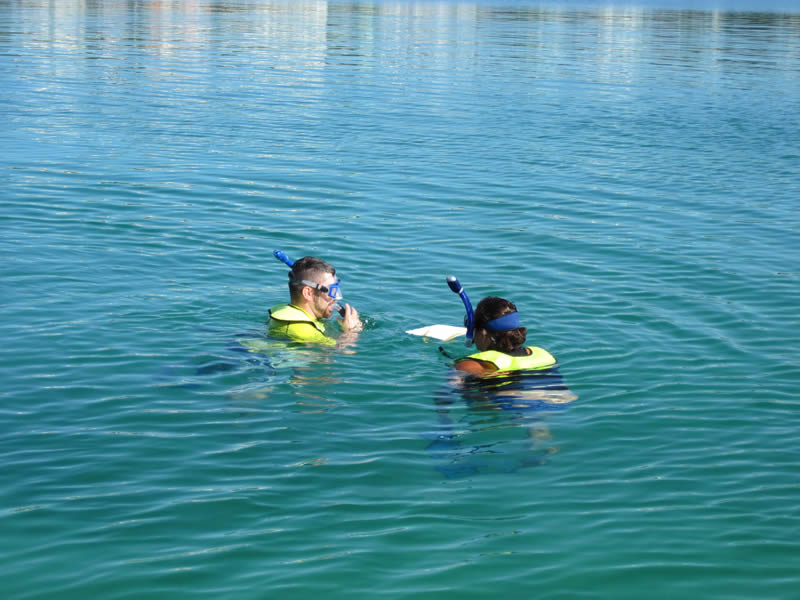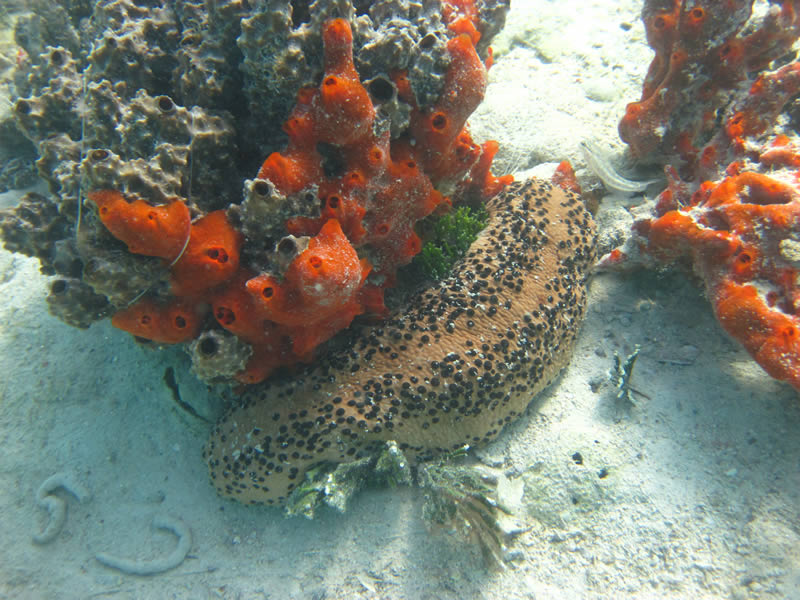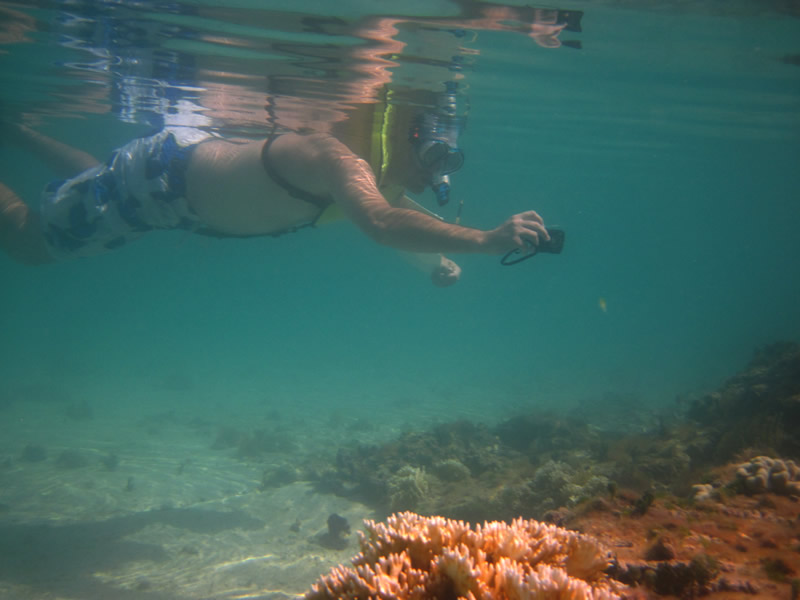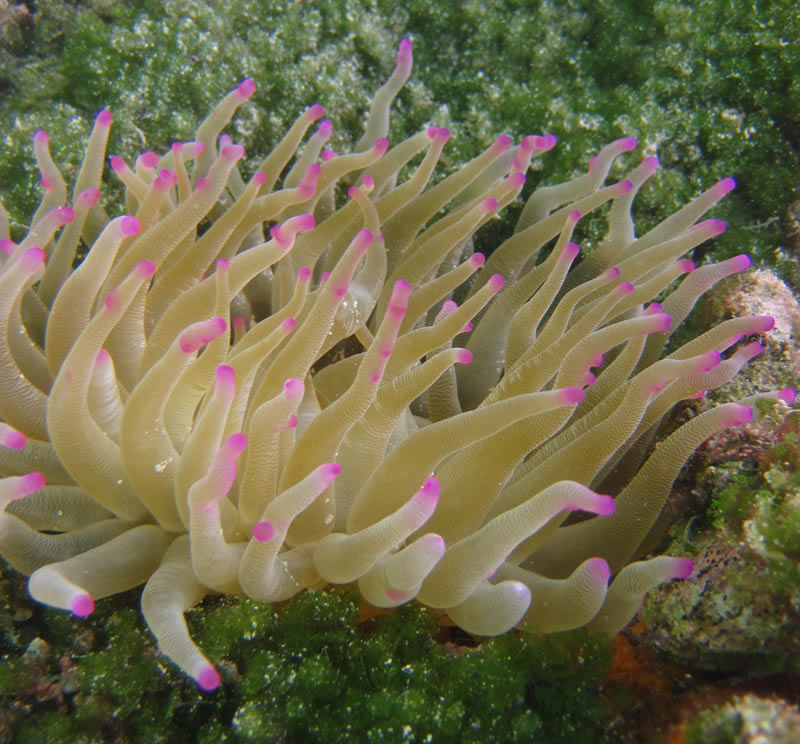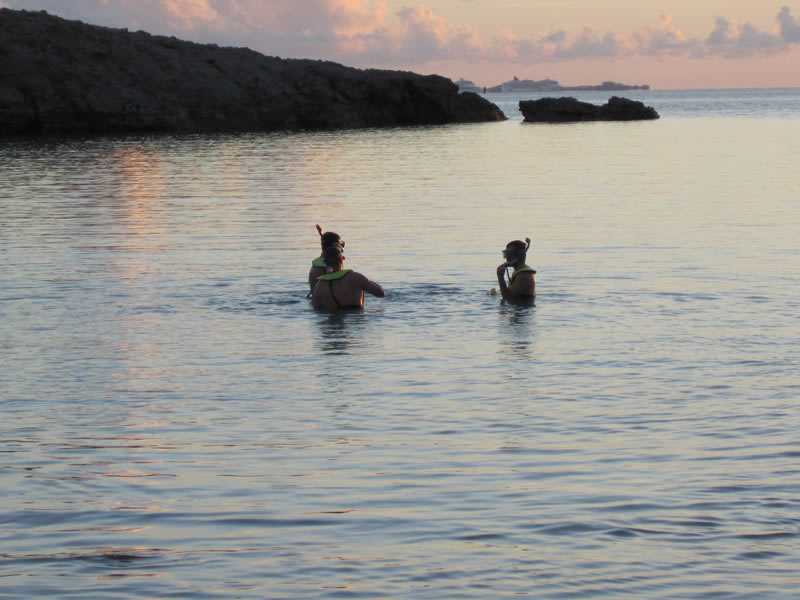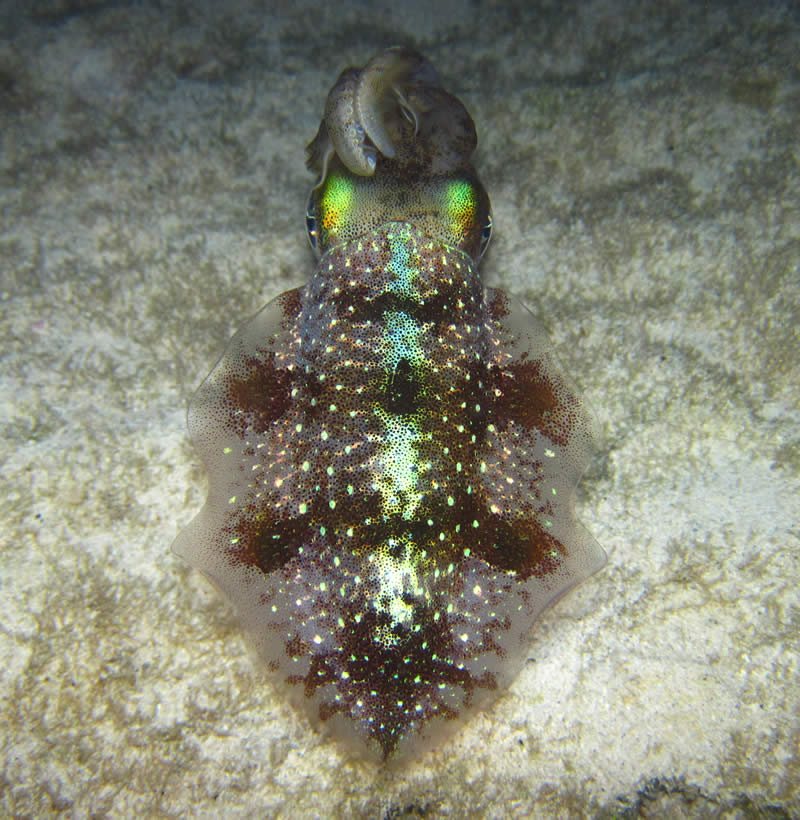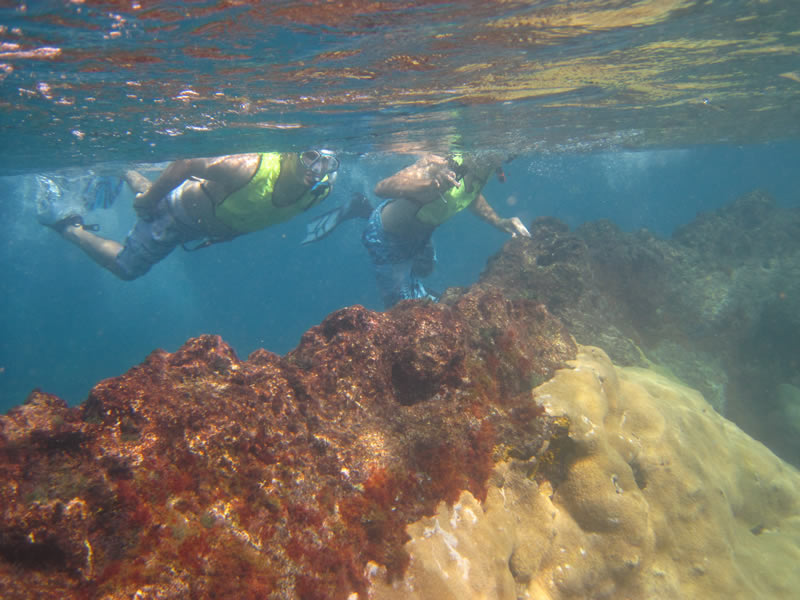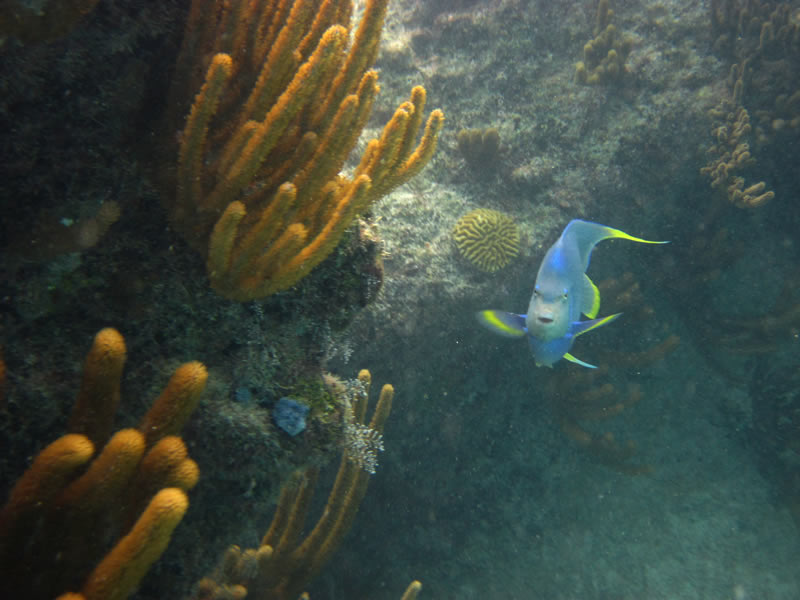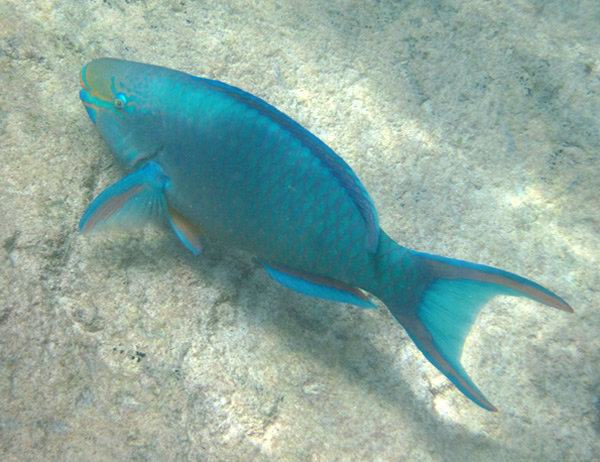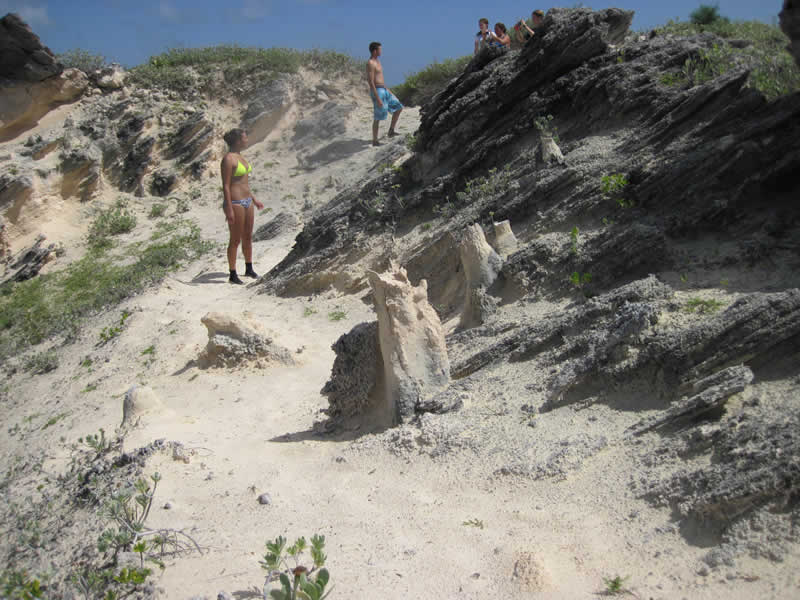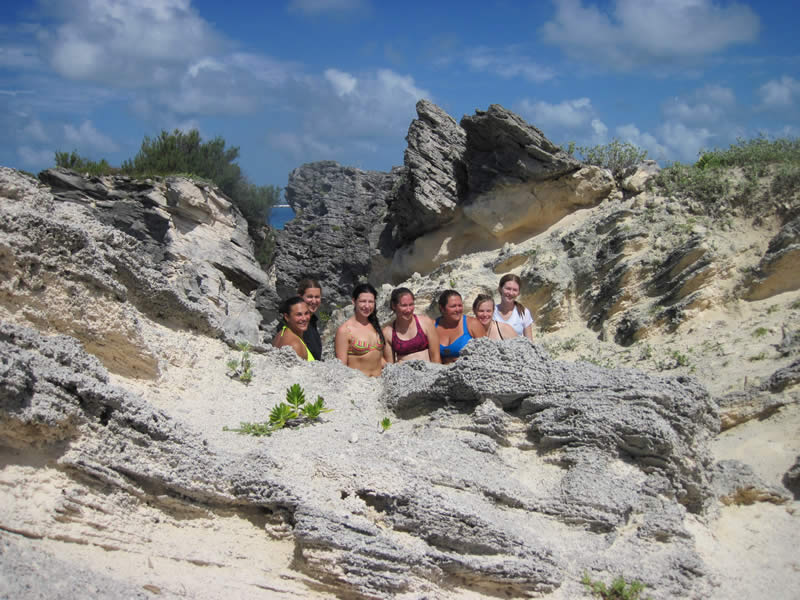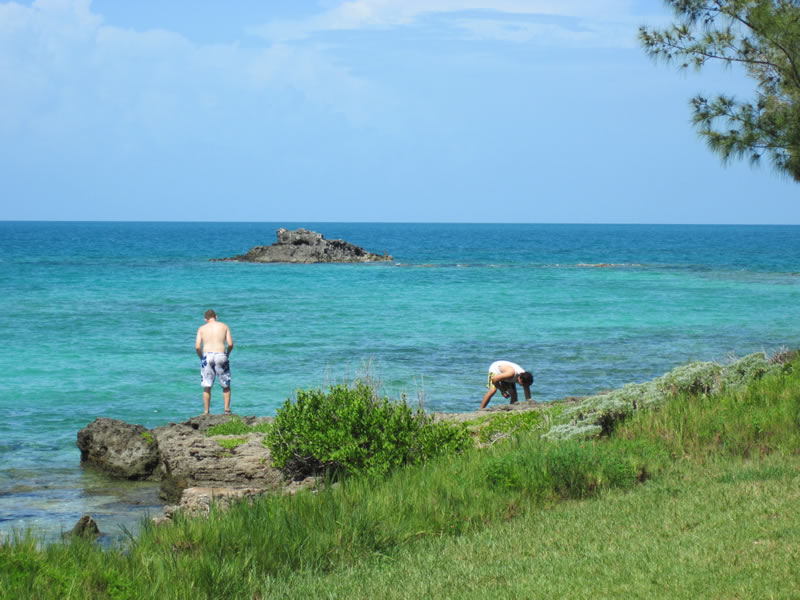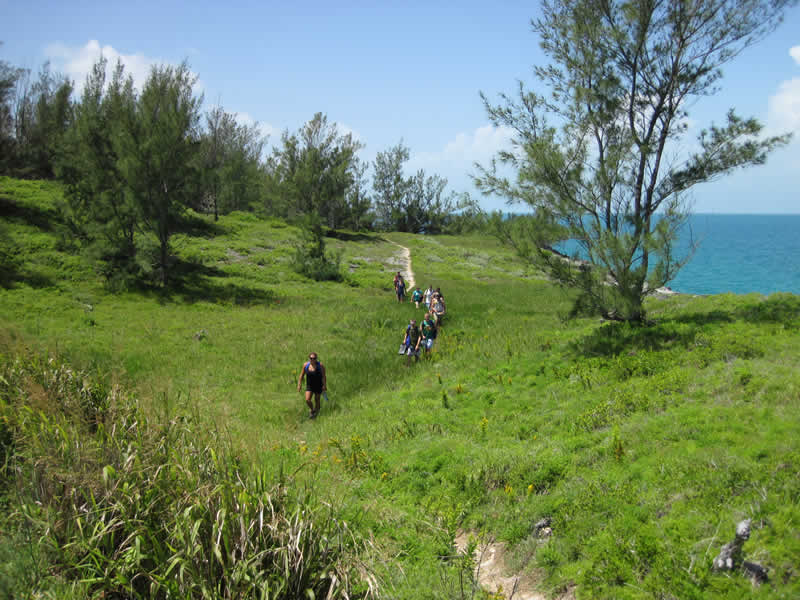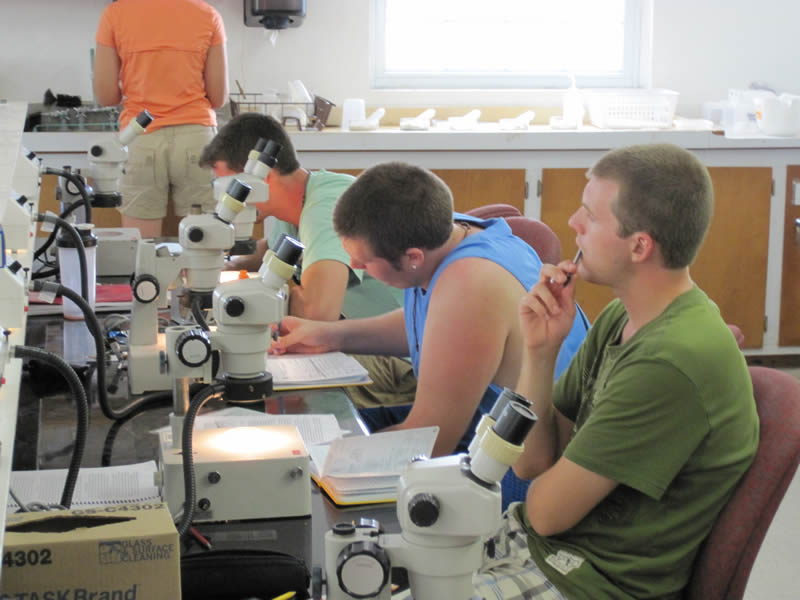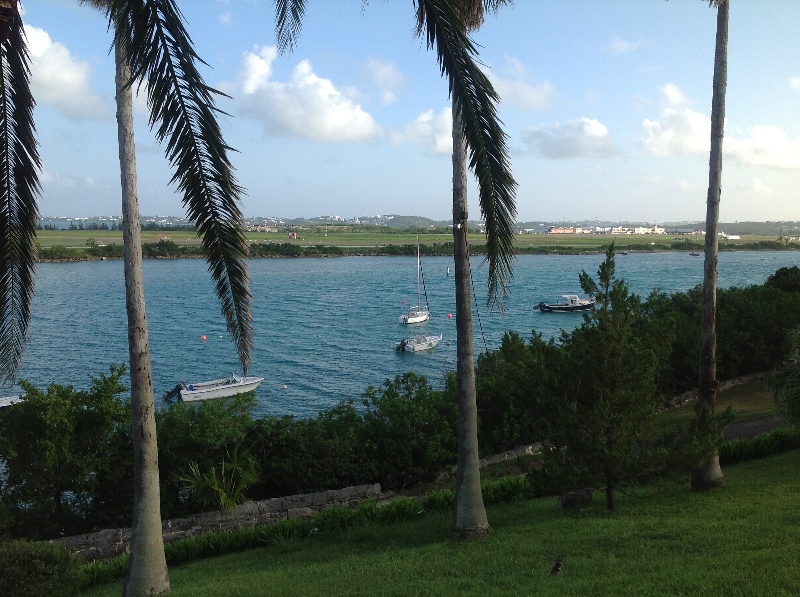| Back to Bermuda Page |
| Back to Other Courses |
| Back to Eric Hiatt's Page |
11:00 PM Monday, August 27. We had to leave Bermuda today... but first we went to the beach! We took a quick trip to Tobacco Bay and spent some time relaxing and exploring this small bay. After an hour or so, we traveled into historic and picturesque St. George's to shop for souvenirs. Then it was back to BIOS to clean up and finish packing before heading to the airport. We had a slight delay in Philadelphia, a quick flight to Milwaukee and Oshkosh, and made it back with only one piece of luggage delayed.
One last swim at Tobacco Bay before heading back to Wisconsin.
Joe helping Sam through the water.
Joe with his Dr. Mode/UW-Oshkosh Bermuda-modified shirt.
Ryan and Eric checking out the critters living on the rocky shoreline at Tobacco Bay.
Wait... who is supposed to be watching Sam?
Tom in the village square stockade in St. George's.
|
11:30 PM Sunday, August 26. Our last full day on the island included sampling sediments in the deepest part (about 70 feet) of the inner ocean areas -- Shark Hole in Harrington Sound. We lowered a sampling device to the bottom using the wench on the Henry Stommel and collected a muddy hydrogen sulfide-rich sediment sample. We then explored the coral communities around a rocky island in the sound before heading to Grotto Bay. The rest of the day was all caves. We first snorkeled in a large seawater-filled room of a cave on the Grotto Bay Resort property, then hiked up to do tours in two commercial caves where the cave formations and geology are spectacular.
Sam working hard to get everything down.
Eric also hard at work.
Watching the deep-water sampler being lowered to the seafloor in Harrington Sound.
We sampled the seafloor using a special device. Mud on the bottom from about 70 feet down contains trace amounts of reduced sulfur that has a characteristic aroma.
Ben and Eric getting ready for a another snorkel in Harrington Sound.
Large bottom-dwelling jellyfish (Cassiopea sp.). This jellyfish, like reef-forming corals, has photosynthesizing single-celled organisms that live in its skin. This allows the animal gain energy while sleeping during the day and filter feed at night -- 24-hour a day "eating".
Pink-tipped anemone in Harrington Sound.
We felt like we were being watched...
Another sea anemone.
Unloading samples and equipment from the R/V Henry Stommel at the end of the day.
Snorkeling and checking out a cave.
Floating in freshwater that is itself floating on seawater below.
A layer of freshwater about 6 feet thick floating on about 20 feet of seawater below in a commercial cave.
Very nicely preserved straws, stalactites, and helictite hanging from the ceiling in Fantasy Cave.
Complex stalactites, stalagmites, and columns in Fantasy Cave.
|
10:00 PM Saturday, August 25. We travelled to the South Shore today with a stop at a rocky part of the coast to examine modern intertidal zone processes, and to observe the Pleistocene geology of the area. The rocks contain the record of sea level rise and fall 300,000 to 100,000 years before present. We then headed to one of the best beaches in the world, Warwick Long Beach where cup reefs are within snorkeling distance from shore. After checking out the reefs, we experienced serious beach processes. Next stop was Black watch Pass, which is a deep pass cut through a series of very large ancient wind-blown sand dunes (now limestone). After trying to remove all the carbonate sand from our ears, a process that may take weeks, we headed out to dinner at a restaurant overlooking the ocean next to Fort St. Catherine.
The students at Devonshire Bay Park.
Tom getting ready to take a group photo.
Getting ready to go snorkeling out to the cup reefs just off shore, Warwick Long Beach.
Tashia and Shawn taking a break from serious snorkeling.
View just out of the water of a cup reef below.
The students experiencing beach processes -- erosion, abrasion, and deposition.
Click on the image below for a video (you may want to turn down the sound because of the wind noise):
|
9:00 PM, Friday, August 24. Our first stop today was seven miles out across the volcanic atoll at North Rock. We dove on a giant cup reef that rises about 25 feet from the seafloor and faces the full force and fury of the North Atlantic -- an incredible structure and home to blue parrot fish, blue and black angelfish, and many others. Our next stop was inside the breaker zone on more normal coral reefs, then we dove on reefs about 5 miles further toward land at Three Hill Shoals. After returning to BIOS we made a quick transition to examine an outcrop of the most ancient limestones exposed on Bermuda, the one that contains most of the caves on Bermuda. We got cleaned up and spent two hours in the lab examining samples we collected during the day, had a great dinner of curry chicken, and then, of course, an enthralling night lecture.
|
11:30 PM, Thursday, August 23. Today was warm and calm. We mapped out the ecological zonation from a rocky shoreline into deeper water in Harrington Sound; this location is marked by very high biological diversity and rapid carbonate sediment production. We made a lunch stop at the the Bermuda Aquarium, and then had a great stop at Bailey's Bay -- a sea grass meadow where several sea turtles stopped by for lunch. After returning to BIOS, we had two hours of lab time, dinner, then a hike and nighttime snorkel at Whalebone Bay to see what organisms "work" the night shift.
Students doing an ecological study in Harrington Sound.
Orange (Cliona sp.) and brown sponges and a "sea pudding" sea cucumber in Harrington Sound.
Eric Plante taking an underwater photo in Harrington Sound.
A nice sea anemone in Harrington Sound.
Waiting for the sun to go down before we head out for a night snorkel in Whalebone Bay.
During our night snorkel several squid were attracted to our underwater lights. I think this one saw his reflection in my light and thought it was another squid. The squid was flashing the brown and emerald green spots as he approached.
|
4:30 PM Wednesday, August 22. We went out on the boat (Research Vessel Henry Stommel) to some spectacular reefs on the south shore, a high-energy, wave-swept passage between two islands, and a beautiful remote sandy beach. We also hiked up a sea cliff formed on a large Pleistocene eolian dune to examine fossil palm tree trunks. The palm trees lived on these high, wind-swept dunes about 125,000 years ago!
Students checking out the rim of a giant cup reef.
A large blue angelfish behind the main reefs. The angelfish is about 12 inches tall.
A large (18 inches long) stop light parrot fish.
Students checking out the fossilized palm forest on an ancient (125,000 years before present) wind-blown sand dune.
Posing for a photo on top of a 125,000 year-old wind-blown sand dune.
|
11:00 PM Tuesday, August 21. We hiked to Whalebone Bay, examined outcrops along the way, and then spent about 3 hours exploring shallow carbonate environments in Whalebone Bay. We had lunch on the beach and then examined more Pleistocene outcrops on the way back along the north shore sea cliffs. After everyone got cleaned up a bit, we spent a couple hours in the lab and then dinner and of course an exciting wrap-up lecture. Everyone should sleep well tonight.
Matt and Ben exploring the rocky shoreline community at Whalebone Bay.
Hiking along the North Shore.
Matt (front), Joe, and Sam working hard in the lab.
|
9:00 PM Monday, August 20. After a long day of travel, we made it! We arrived at 4:30 PM, had a tour of BIOS, a short practice snorkel, dinner, and an exciting introductory lecture. Here is a photo of Ferry Reach from the balcony where we had dinner.
View from the BIOS balcony where we ate breakfast and dinners. |
Students were able to go on this trip with financial help from generous donations made by alumni of the trip, Kelley and Hendrik Steffen-Braaksma, Dr. John Rivers, and generous support from the ExxonMobil foundation.
|
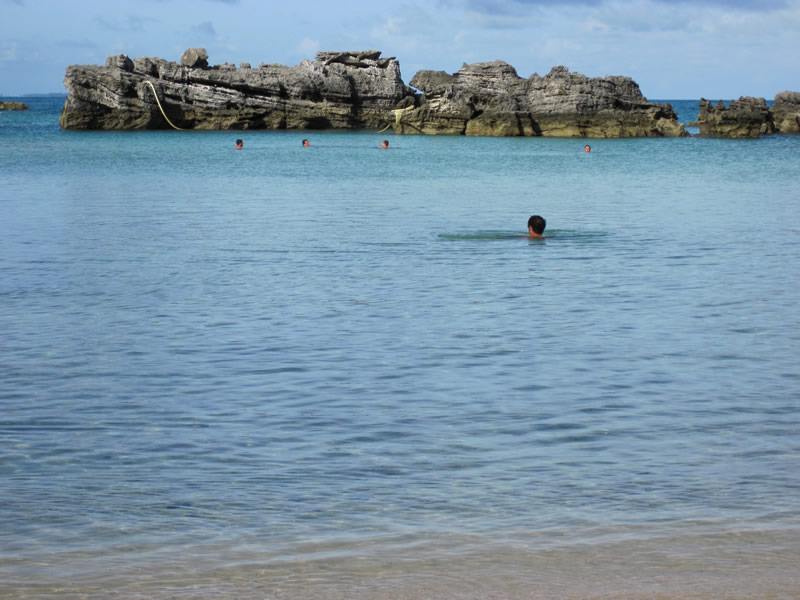
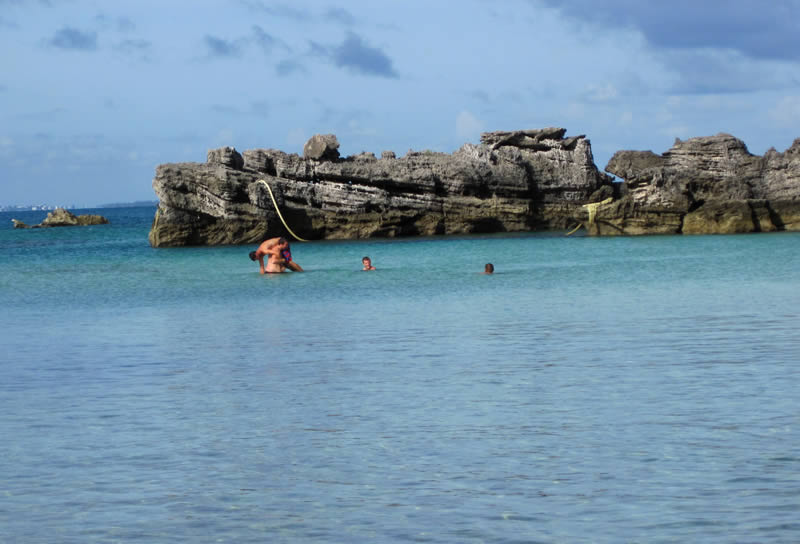
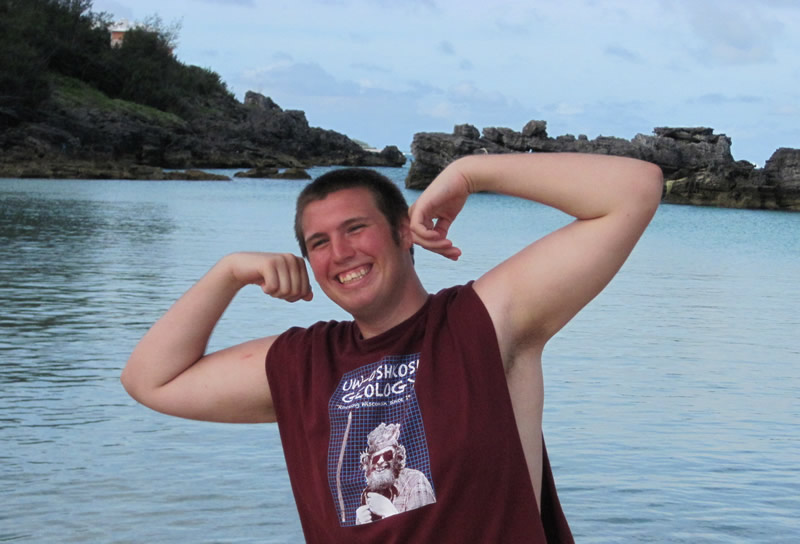
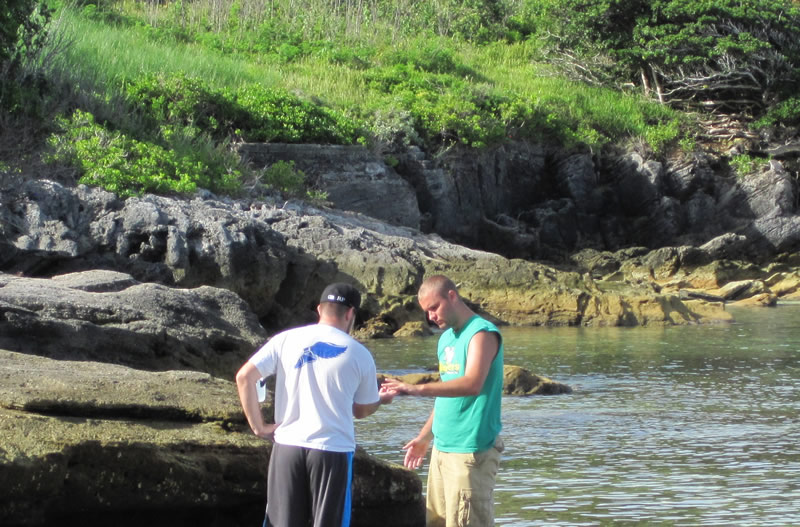
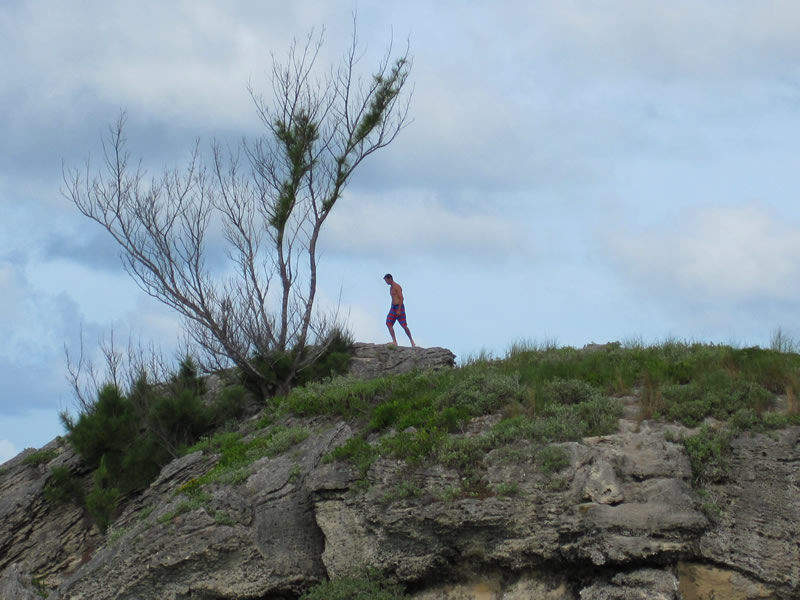
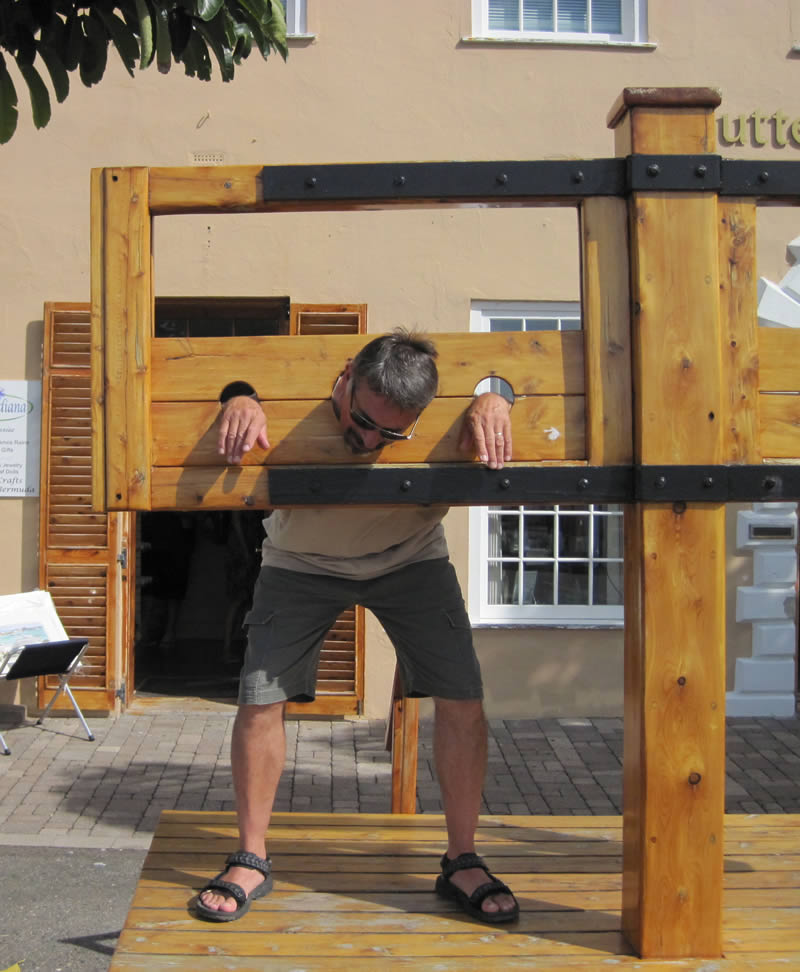
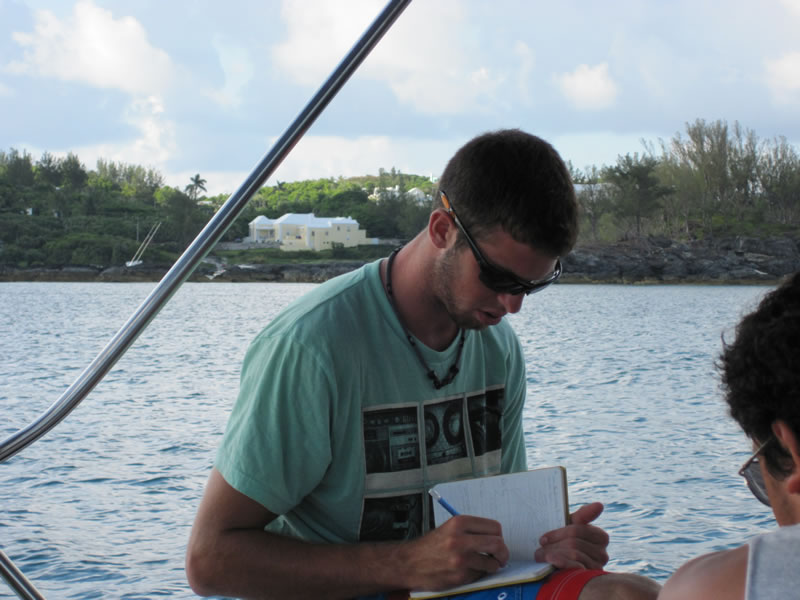
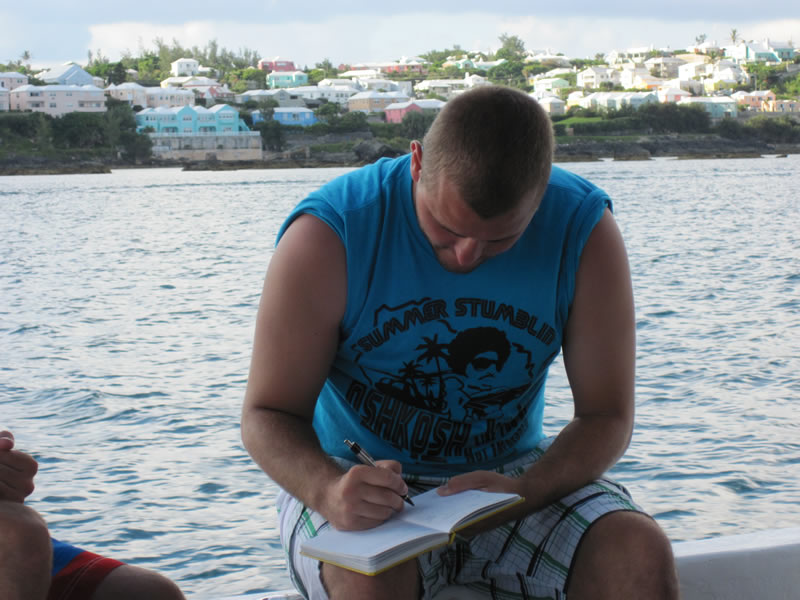
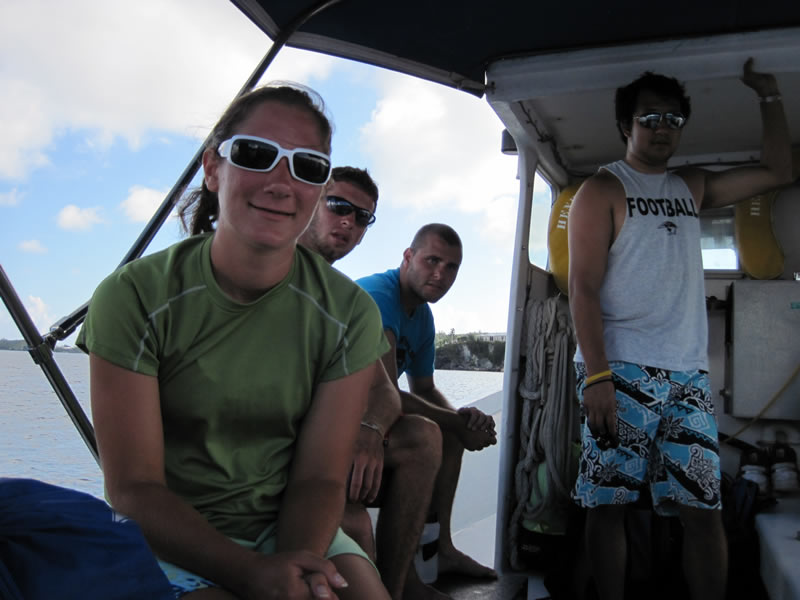
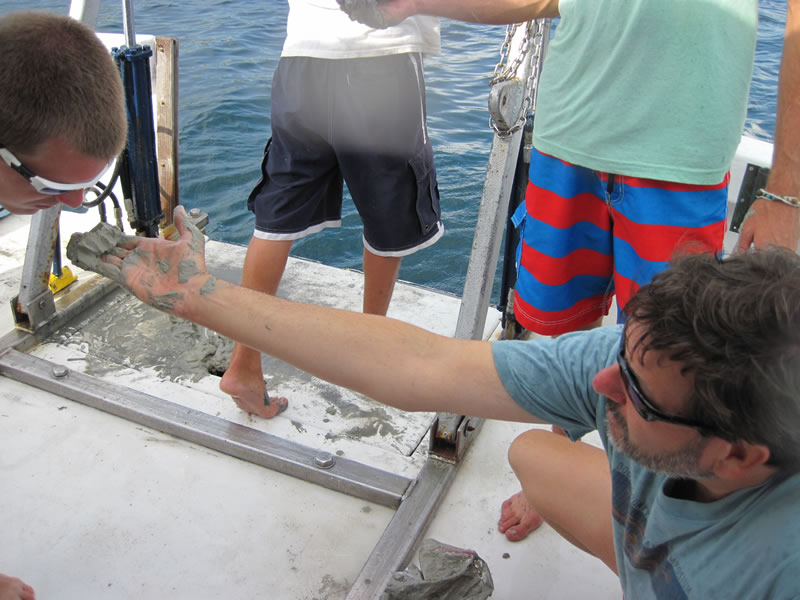
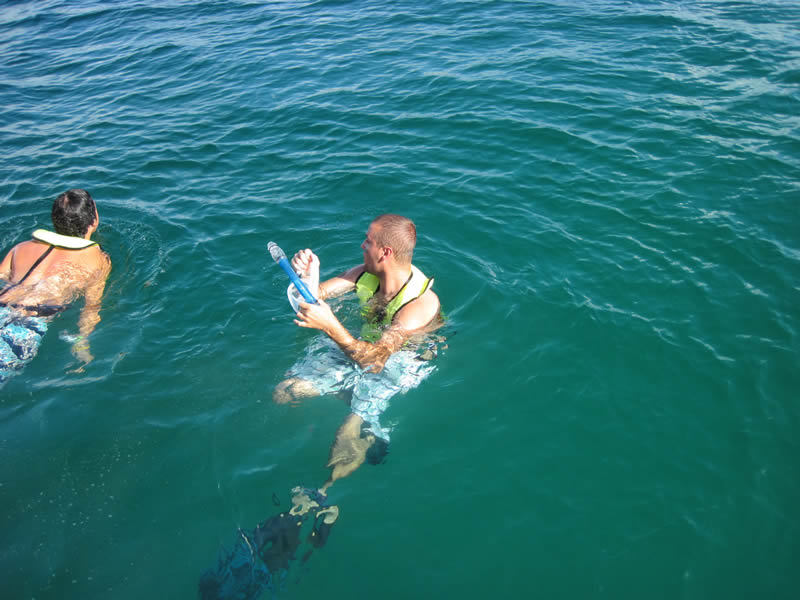
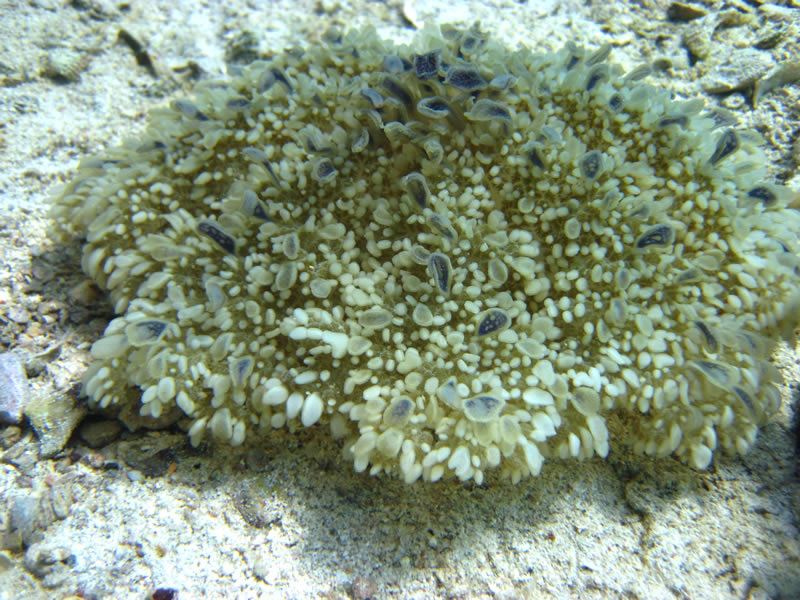
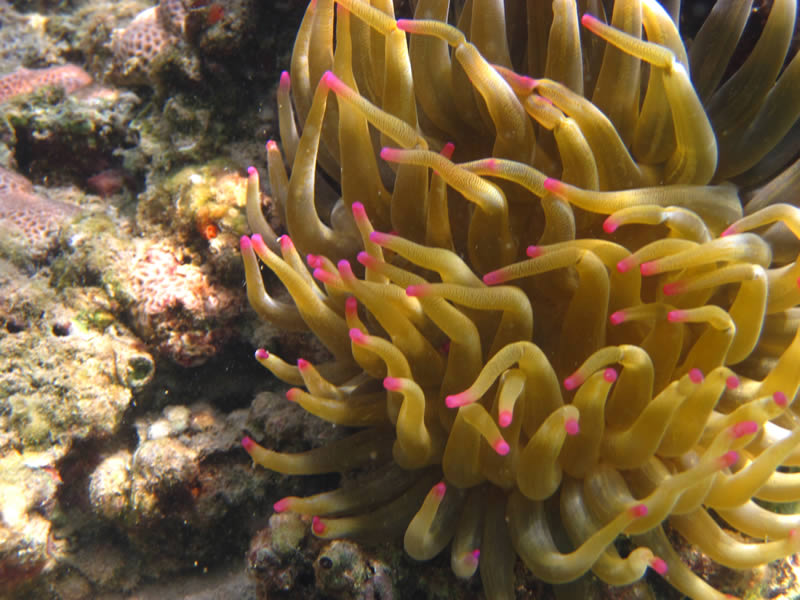
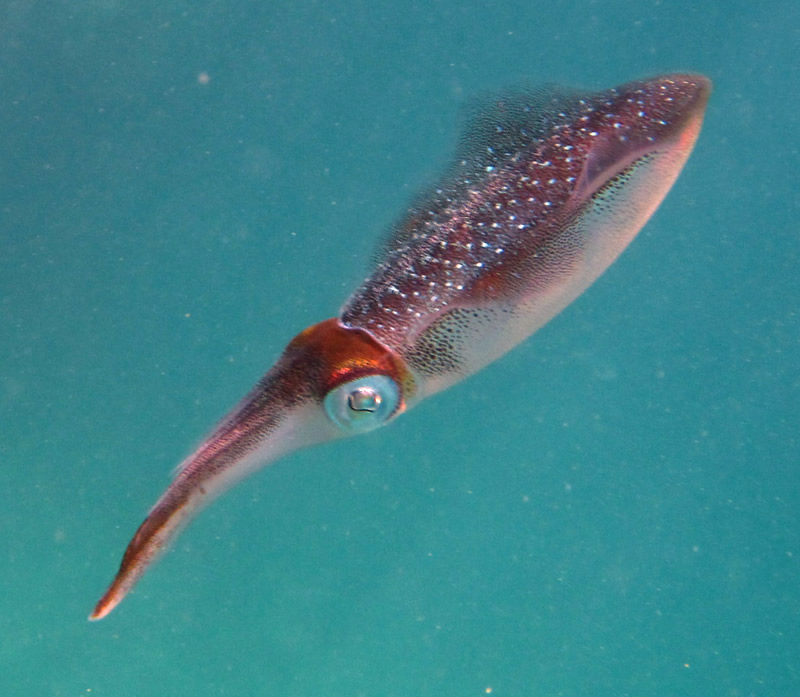
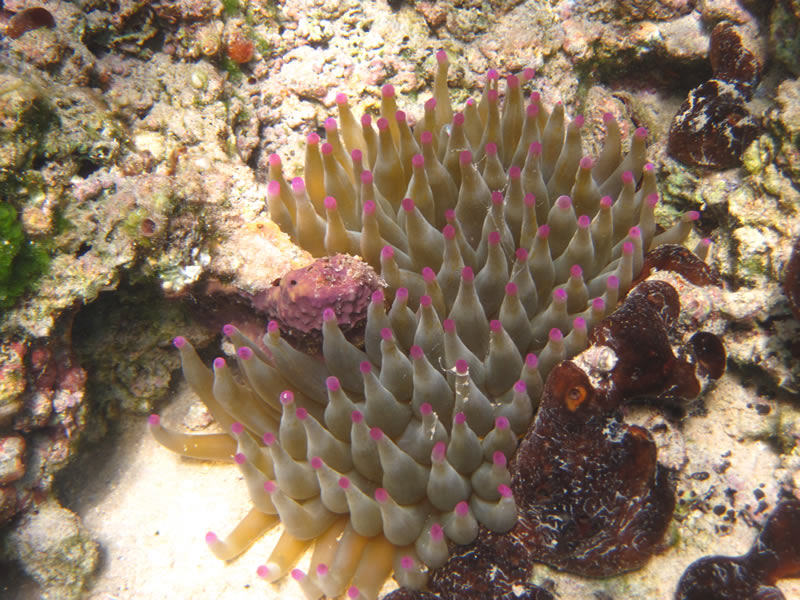
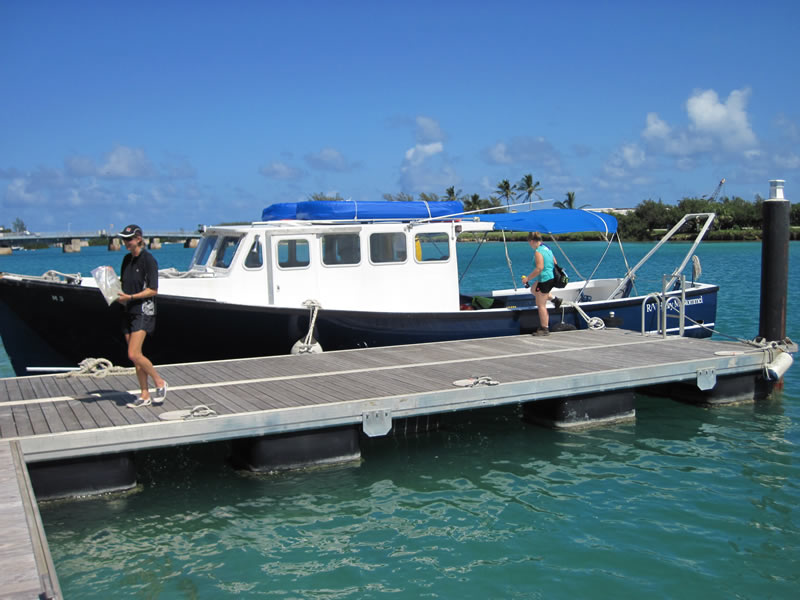
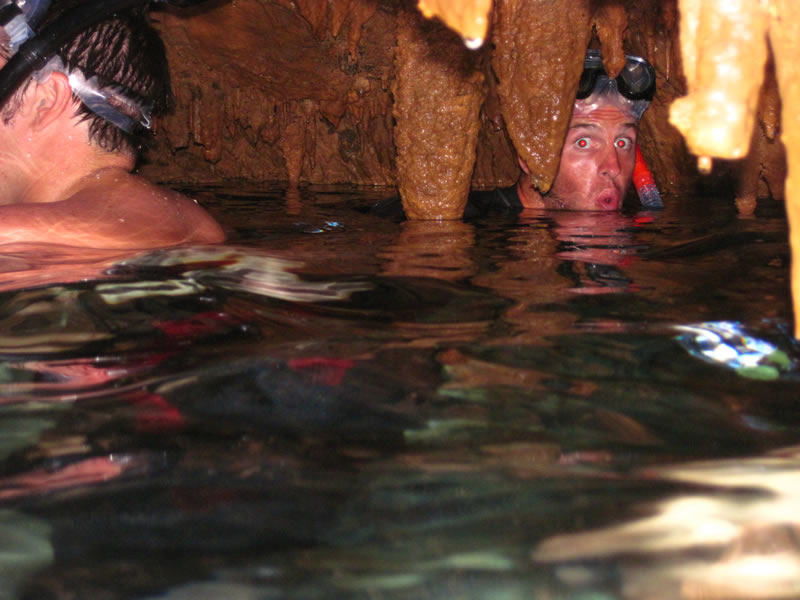
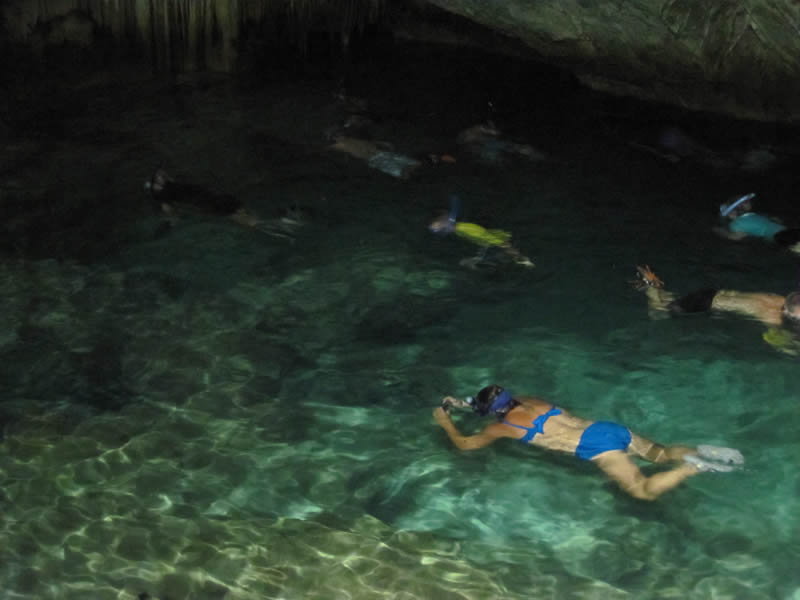
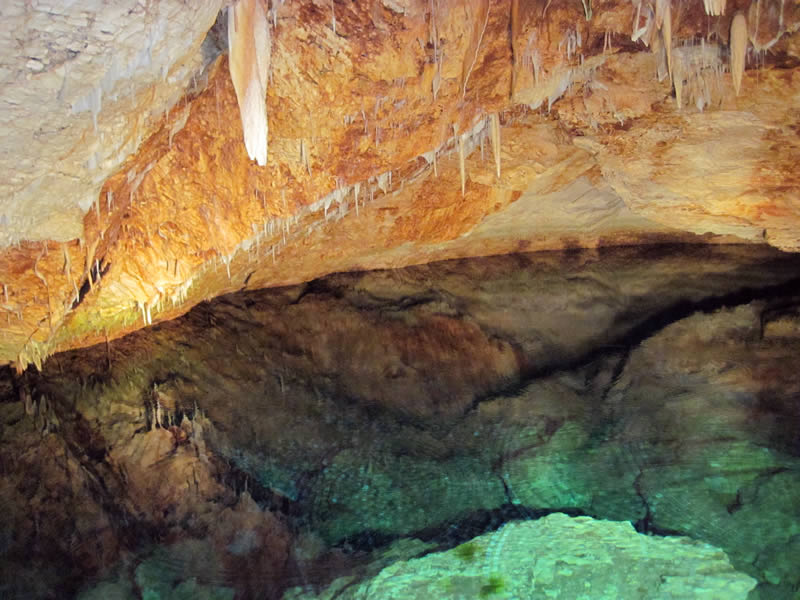
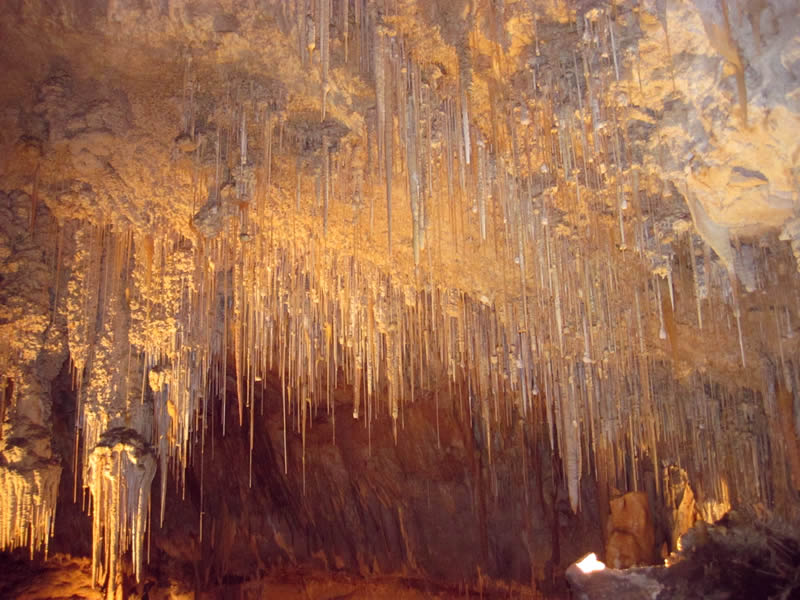
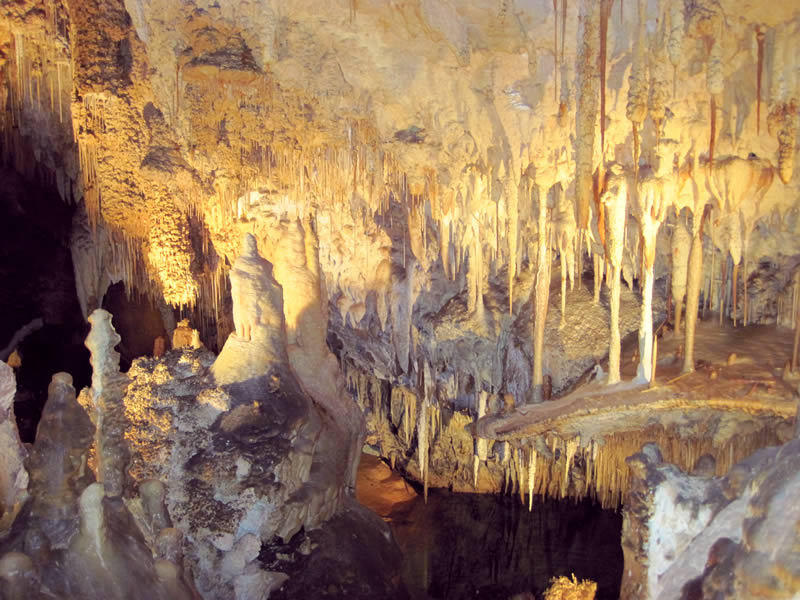
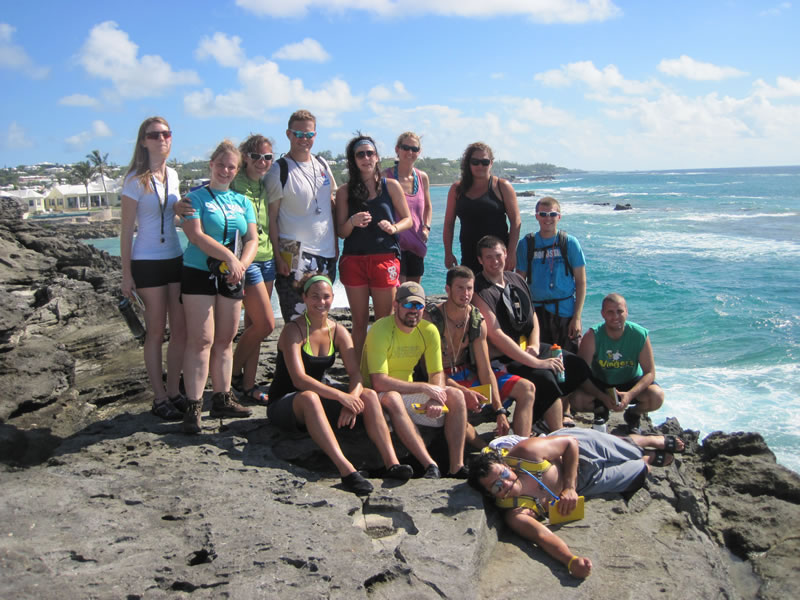
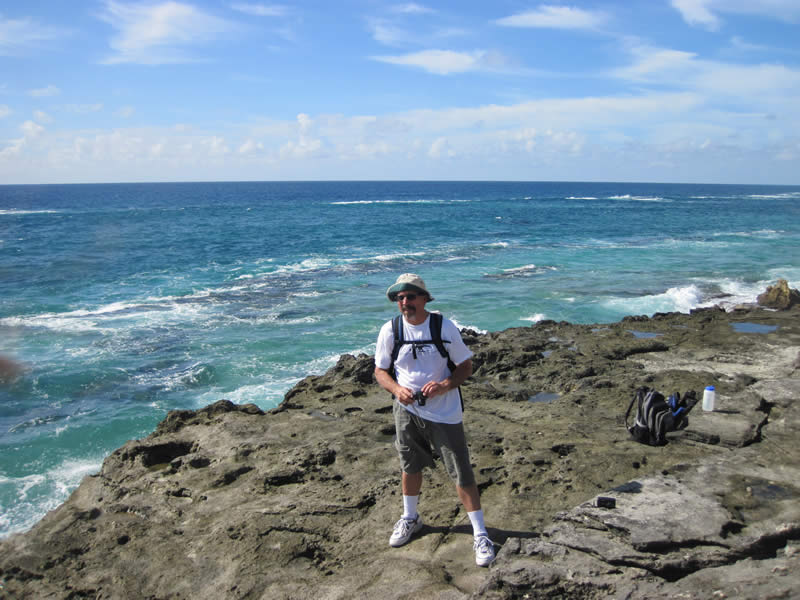
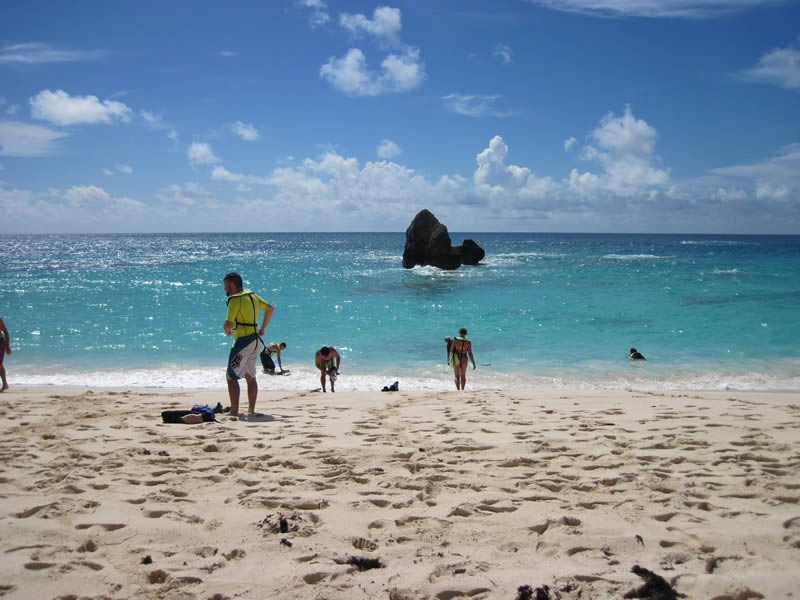
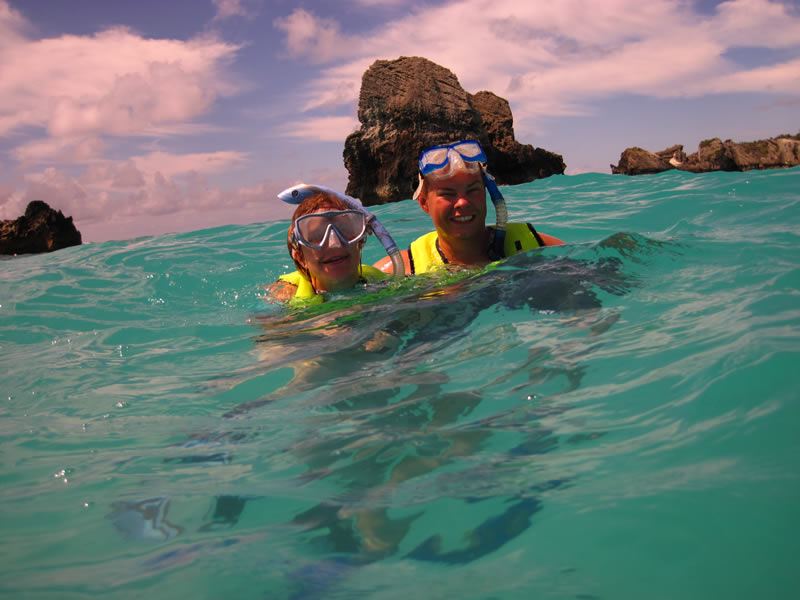
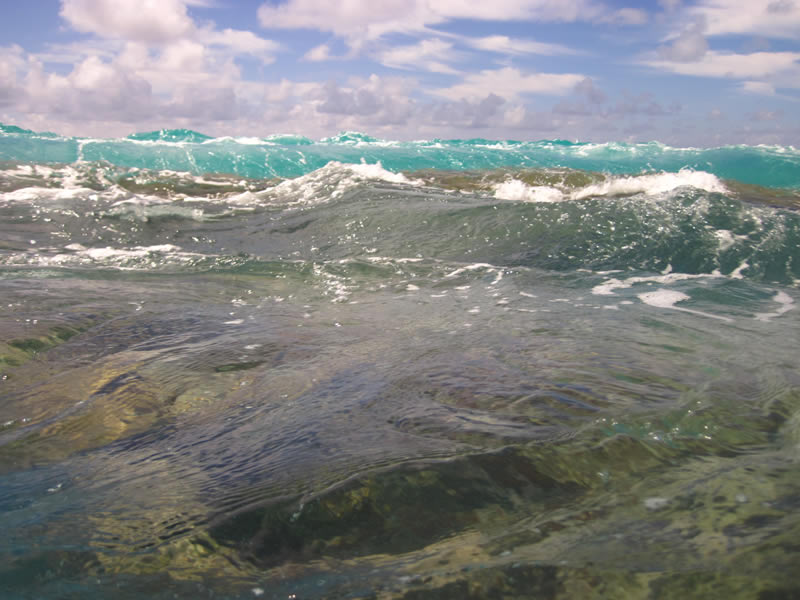
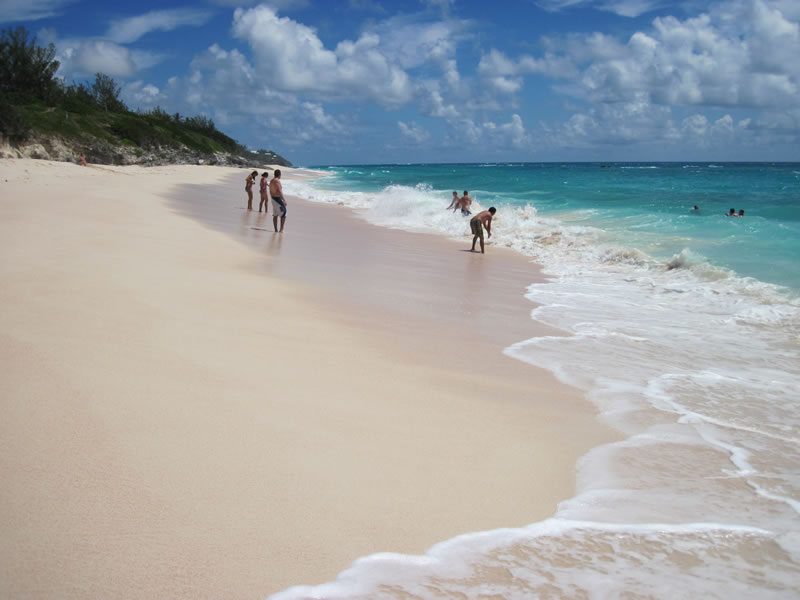
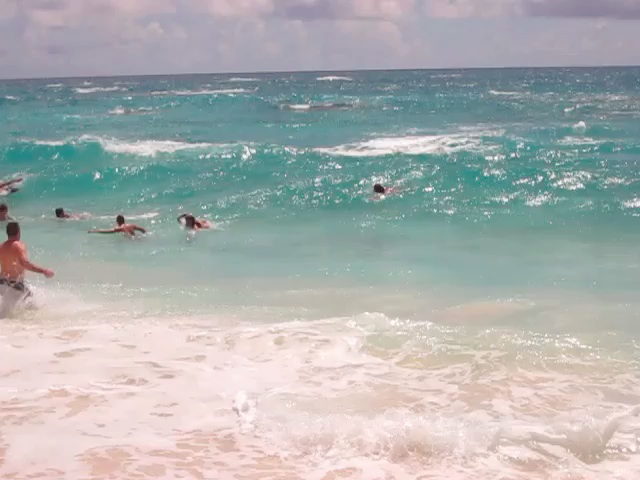
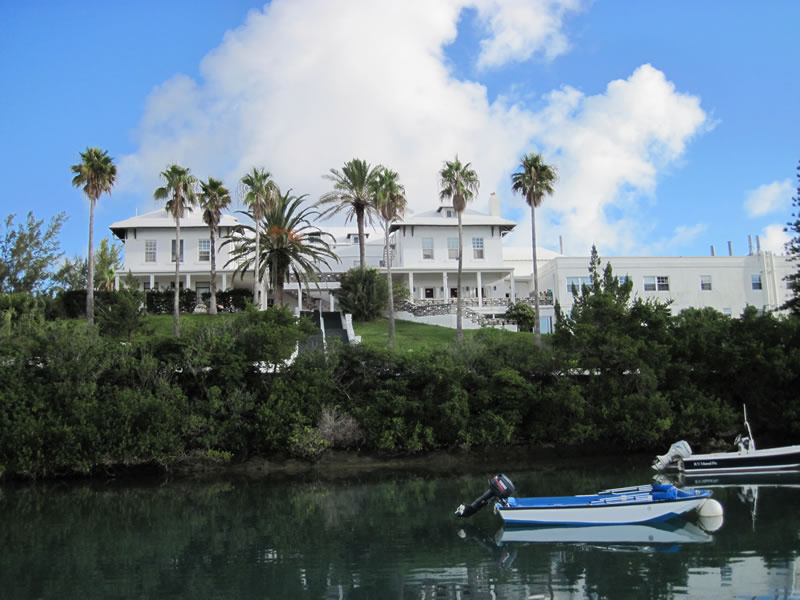 BIOS main building where we are staying. Sleeping quarters are mostly upstairs, and we eat our meals on the first floor balcony (see view from balcony below).
BIOS main building where we are staying. Sleeping quarters are mostly upstairs, and we eat our meals on the first floor balcony (see view from balcony below).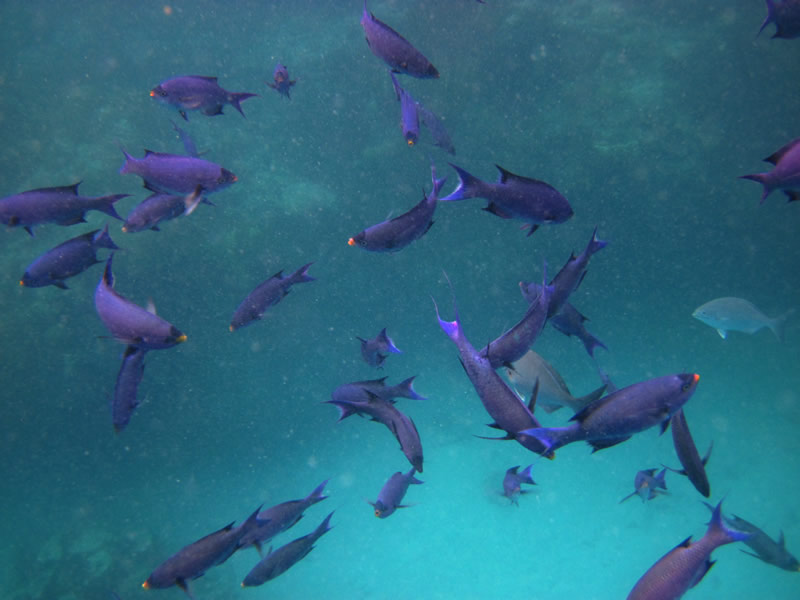 Students diving off the boat attracted some curious onlookers.
Students diving off the boat attracted some curious onlookers.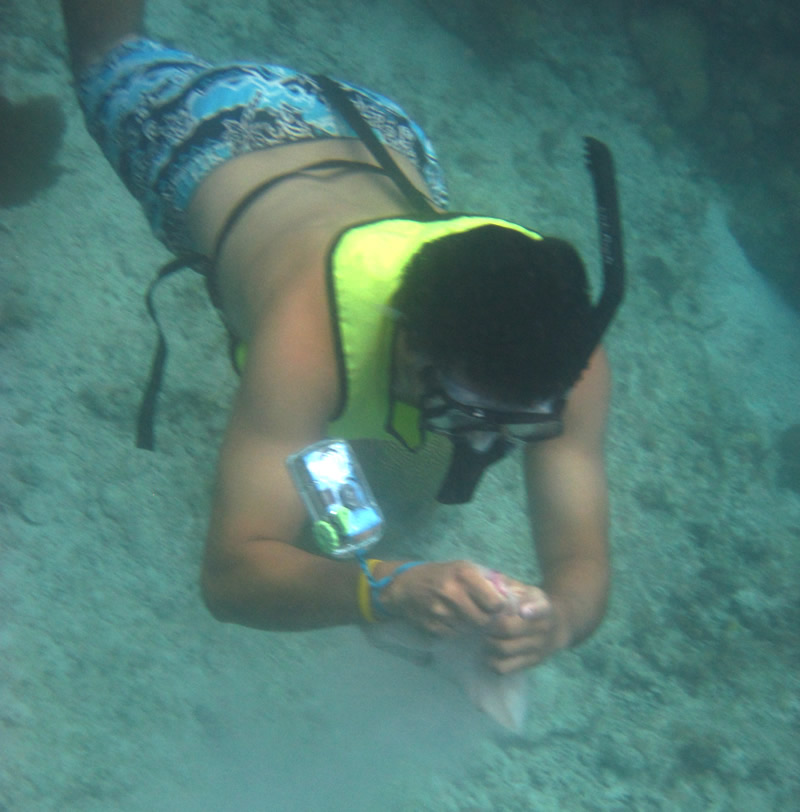 Ben collecting a sediment sample.
Ben collecting a sediment sample.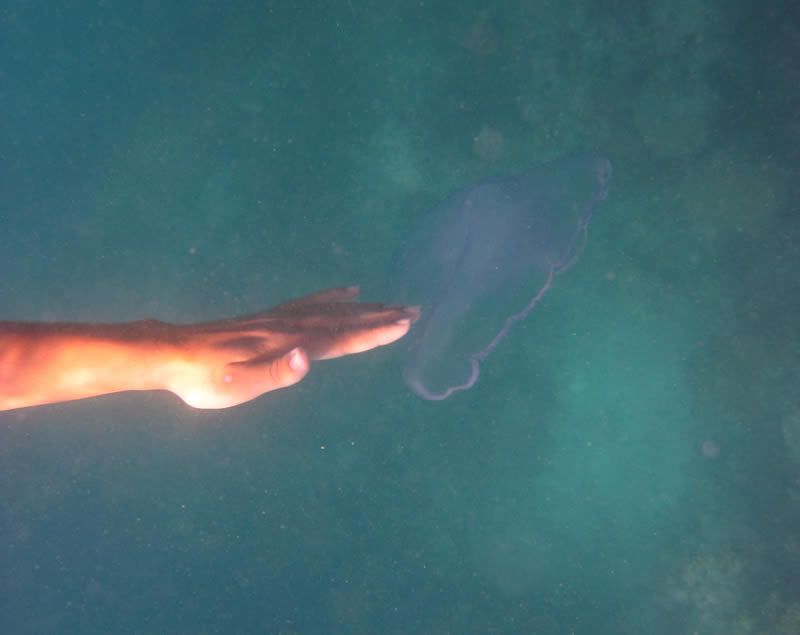 Sometimes the best way to overcome jellyfish anxiety is to face it head on...
Sometimes the best way to overcome jellyfish anxiety is to face it head on...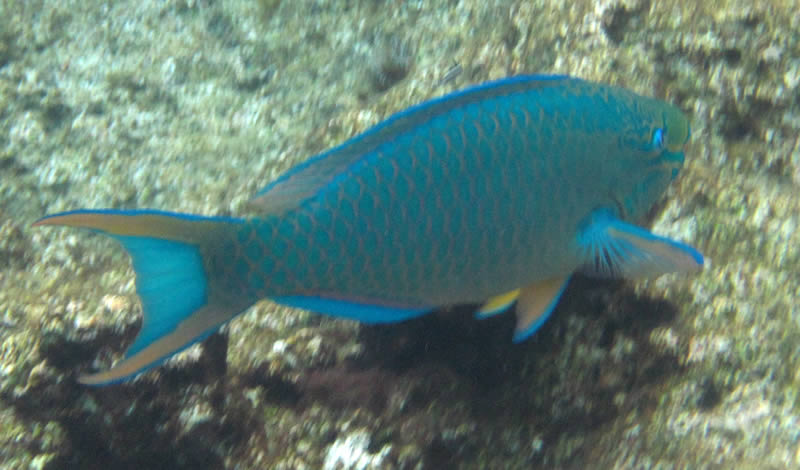 Blue stoplight parrot fish at North Rock.
Blue stoplight parrot fish at North Rock.